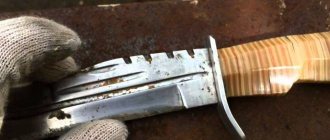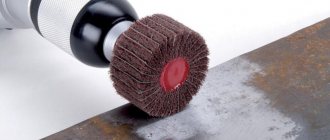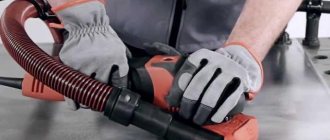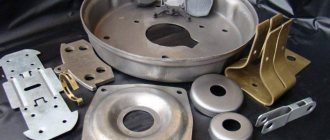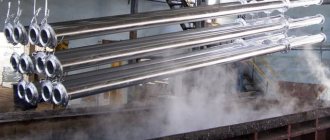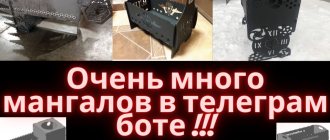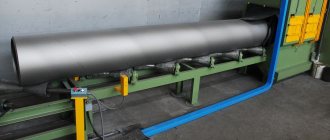When manufacturing or repairing metal products, there is often a need to create a beautiful front surface . To achieve a decorative aesthetic effect, a finishing treatment called polishing .
Polishing technology has been known since Neolithic times, 8000 BC. Products made of bone, stone and native metals (copper, gold and silver) were polished. Among the famous finds of the Neolithic era are polished slabs of obsidian and basalt, which served as a mirror.
Polishing is the final stage of metalworking. During polishing, the thinnest top layer is removed, which allows you to remove roughness, abrasions and small scratches. The polished metal surface acquires a beautiful mirror shine.
In this review you can find out how to polish metal products and what is needed for this.
Polishing metal to a mirror shine with your own hands
Share on social media networks:
- Polishing at home
- Mechanical polishing methods
- Stainless steel care
- Video material
Stainless steel items have become a part of our lives. These are interior elements for the street and at home, various dishes at home and much more. Stainless steel is an alloy of iron and carbon mixed with special elements. Steel acquires high resistance to negative environmental factors thanks to these elements. But under the influence of various factors, even such a durable metal can lose its original appearance. How to polish to a mirror shine? If such a need arises, then you have two options:
- Contact a specialized company that provides this type of service.
- Do it yourself at home.
Let's look at how to polish metal to a mirror shine with your own hands in different ways at home.
Required equipment and chemicals
To get a good result at home, you will have to spend a little money and stock up on some chemicals, devices and mechanisms. Depending on the method by which you will polish the metal to a mirror shine with your own hands, you will need several items from this list:
- Sulfuric acid;
- Nitric acid;
- Water;
- Sawdust;
- Paste GOI;
- Felt circle;
- Drill;
- Wooden block;
- Textile.
Polishing at home
You can also get a shiny and smooth stainless steel surface at home. There are several ways that will help us with this.
Preparation for polishing
First you need to clean the product properly. You can use dishwashing liquid for this:
- Dilute the detergent in water.
- Clean the stainless steel surface with soapy water.
- Rinse and dry the product thoroughly.
Olive oil polishing
This method is suitable for polishing tarnished items. All you need is a little olive oil and a soft cloth or napkin:
- Apply a little oil to the fabric and spread it so that the entire surface is covered with an oil film.
- Press the fabric firmly onto the surface and polish the stainless steel product with smooth movements.
Important! Continue until you see a noticeable change in structure.
- Now you need to remove the remaining oil. Napkins or a dry towel are suitable for this. Wipe the surface until it is completely dry.
Polishing with flour
How else can you polish metal at home? For these purposes, you can use flour, however, this method is more suitable for flat surfaces, for example, for pots, knives or a sink:
- Sprinkle flour over the entire surface and spread it evenly over the metal.
- Polish using a soft cloth in a circular motion.
Important! For greater effect, you can use an old toothbrush.
- Shake off any remaining flour.
Chemical method
You can polish metal at home using a chemical method. To do this you need to prepare a special liquid. There are several ways to do this:
- For such a solution you will need 230 ml of sulfuric acid, 70 ml of hydrochloric acid, 40 ml of nitric acid. To 1 liter of solution you need to add 6 g of acid black dye, 10 g of wood glue and 6 g of sodium chloride. Bring this mixture to a temperature of 65-70 degrees and place your stainless steel items in there for 5 to 30 minutes.
- The solution is prepared in the following ratios: phosphoric acid 20-30%, hydrochloric acid - 3-4%, nitric acid - 4-5%, methyl orange - 1-1.5%. Place the product for 5-10 minutes at a temperature of 18-25 degrees.
- Per liter of composition there are 660 g of hydrochloric acid, 230 g of sulfuric acid and 25 g of orange acid dye. Heat the solution to a temperature of 70-75 degrees and place a stainless steel object there for 2-3 minutes.
Important! All these components are very aggressive, so it is necessary to ensure complete eye protection. hands, face and respiratory organs.
The stages of polishing using chemical solutions are as follows:
- Immerse the pre-cleaned stainless steel item in a container with a chemical solution.
Important! Adhere to a strict dosage of substances included in the solution to obtain the desired concentration.
- The liquid must be stirred constantly.
- After the expiration date, the product must be removed and the remaining reagents washed off with clean water.
- Wipe the part with a cloth containing polish.
Under the influence of chemicals, all roughness will be eliminated and the product will acquire its original shine and radiant appearance.
Mechanical polishing methods
These polishing methods involve the use of tools and devices such as:
- polishing machine;
- Sander;
- electric sharpener;
- drill with lock.
Important! The method has a number of advantages. This is fast, efficient, you can change the rotation frequency of circles and belts, use additional attachments made of leather, fabric, wool and other materials.
The product for polishing metal to a mirror shine with your own hands depends on the brand of stainless steel:
- Diamond paste performed best, but it has one significant drawback - a rather high price.
- If you don’t have one, then you can use GOI paste. It comes in four types, depending on the grain size.
Important! For manual grinding, you can use the same diamond paste or GOI paste. Its effectiveness depends on the quality of consumables.
This is done as follows:
- Apply a little product to the felt disc and add a few drops of machine oil to dilute the paste.
Important! For metal, it is best to use a coarse grit paste.
- Polish the surface in a circular motion, being careful not to rub too hard.
- Do this until you are satisfied with the result.
Important! How can you polish a knife to a mirror shine at home? Such smooth metal surfaces are polished with an ordinary file - a wooden block covered with a cloth, onto which polishing paste is applied.
How is stainless steel polished?
When mechanically polishing stainless steel, microprotrusions of the metal are cut off using abrasive grains. In this case, the tools used are circles, discs, rollers and tapes, and the abrasive materials are polishing pastes and suspensions.
Interesting materials:
How to remove old rust stains? How to remove construction paint from hair? How to remove superglue from a wooden table? How to remove grass from jeans? How to remove grass from pants? How to remove wine from a white T-shirt? How to remove wax from carpet? How to remove old grease stains from silk? How to remove yellow spots from fur? How to remove yellow stains from clothes?
Methods for polishing metal to a shine
To make a metal product the same as on the first day, you will have to try, since there are at least three ways to clean metal:
- Home;
- Machine;
- Classical.
Each of them will require some effort and diligence in order to achieve a good result, but it will meet your expectations.
Home method
To polish a metal product at home, there are many ways, each of which requires certain chemicals. Please note that some chemicals can be hazardous to health, so you must follow safety precautions and adhere to a certain algorithm.
Result
Grinding and polishing metal at home, carried out in compliance with all technical requirements, can completely restore the appearance of a metal object. With minimal financial costs and a certain skill, you can achieve high results.
If you need to compare your work with the ideal result, you can always watch a video on the Internet - “Grinding and polishing metal at home”, where you can find lessons on various polishing methods. They tell in detail about all the nuances of polishing metals at home.
Types of jobs
Metal polishing can be carried out using the following methods:
- mechanical or abrasive polishing of products;
- chemical treatment using special substances, for example, paste;
- electrochemical method;
- electrolyte-plasma method.
Some types of finishing sanding are simple and do not require special materials or equipment. For example, the mechanical method can be used at home. However, it is practically impossible to achieve significant results when using them.
Disadvantages of traditional methods
Polishing metal using traditional methods, abrasive and chemical effects on the surface, has a certain number of limitations in application. These include:
- lack of possibility to automate the process. When carrying out work to obtain gloss, many enterprises introduce automatic processing technology, which can significantly reduce the time it takes to obtain a whole batch. Chemical, mechanical, electrochemical polishing have features that make it difficult to automate the technological process;
- the difficulty of obtaining a mirror surface when using the considered types of impact on metal concerns technological and electrical reasons. Economic reasons are primarily associated with the high cost of production robots and machines that operate on a numerical control system. Technological factors determine the impossibility of incorporating traditional methods of polishing metal products to obtain a mirror surface.
Polishing stainless steel with a felt polishing disc
Often the above problems lead to the fact that the work in question is done by hand using a special paste under mechanical influence. This point determines a significant decrease in productivity, since processing on an automated line is impossible. Due to the use of outdated methods, the production line often results in a conveyor failure, and this negatively affects the cost of obtaining the product and reduces the competitiveness of the enterprise.
Main types of grinding of metal surfaces
A wide variety of technologies are used for the grinding process, and in this article we will look at the most common of them. Let's talk:
- about cylindrical grinding of metal;
- about changes in the roughness of internal surfaces;
- about gear grinding;
- about the essence of centerless technology;
- about grinding flat surfaces.
Technologies are also classified depending on the type of material used when grinding the metal surface. Today, the process has been significantly simplified through the use of special machines, for example, CNC. Their use significantly reduces labor costs and maximizes the quality of the final product.
To use this technology, special equipment is required. The following features of this type of grinding are distinguished:
- The part is processed using an abrasive wheel rotating at high speed.
- To maximize the efficiency of the grinding process, the workpiece itself rotates in the opposite direction simultaneously with the wheel.
- To change the depth of penetration of the tool and ensure the ability to process the part along its entire length, the feed can be carried out both longitudinally and transversely.
Due to the fact that at the moment of rotation the entire surface of the metal workpiece is processed, which ensures the necessary uniformity, this method is often used for processing cylindrical parts.
If it is necessary to process a cylindrical workpiece from the inside, then this technology is used. It differs from the previous method in that the abrasive wheel grinds the part from the inside of the cylinder.
The features of this technology are:
- obtaining transverse and longitudinal feed by the tool and workpiece;
- what basically rotates is the abrasive wheel.
For maximum processing efficiency, coolant is supplied to the grinding zone.
This method is used for grinding gears, which are components of a wide variety of mechanisms. Due to the complex shape of the surface being processed, special grinding equipment is required in this case.
When using this grinding method:
- the profile of the ring gear is processed;
- the circle is changed to the size of the tooth involute;
- special machines are required.
Since in the vast majority of cases the teeth are hardened, the grinding process becomes much more complicated.
With this kind of grinding, the workpiece is not fixed in the centers. The peculiarity of this technology is that the part is processed using two rotating grinding wheels, between which it is placed. To prevent the workpiece from falling through or jamming due to displacement, there is a stainless steel knife in the center.
Such equipment, due to the use of two abrasive wheels at once, greatly speeds up the grinding process. On sale you will find a huge number of machines, the basis of which is the principle of centerless grinding.
Flat housing parts made of various metals are most often subjected to this treatment. Features of this grinding:
- The part is placed on a special table, which ensures reliable magnetic or mechanical fastening.
- The abrasive wheel performs the main rotation, and the part or tool performs the reciprocating rotation.
By choosing a wheel with a suitable profile, you can process parts of the most complex shapes. To avoid overheating and warping when grinding metal surfaces, coolant should be supplied to the contact point between the workpiece and the tool.
Mechanical polishing method
For many years, a mechanical method of processing the surface of a metal product has been used. Special sets of abrasive wheels and belts, when combined with GOI polishing pastes, make it possible to obtain a material with a roughness index Ra = 0.05–0.12 microns.
The features of this password encryption method include:
- to automate the process, special machines are used that are equipped with fabric or felt circles;
- a certain amount of GOI paste is applied to the abrasive;
- the goyi paste in question is a special powder consisting of an active substance that has an activating effect on the surface of the product;
- A typical paste consists of approximately 60% abrasive and 40% binder. content of activating additive 2%.
Finish grinding can only be achieved using GOI paste. In this case, a soft wheel and GOI paste with a fine abrasive are used. For such work, the material consumption is quite large: per 1 square meter of surface there are 0.3 felt wheels and an abrasive substance such as GOI, approximately 100 grams. When processing complex surfaces, a belt type of material and the same GOI abrasive are used.
Special attention should be paid to GOI paste. It is a special substance that is based on chromium oxide. The substance from the GOI category is produced in the form of a green bar. Special GOI sets contain bars with different abrasive grain sizes.
What is grinding of metal surfaces
In the process of creating the required part, the material is subjected to various influences, which do not go unnoticed for the product - various defects inevitably form, such as scratches, slag residues and traces of heat treatment. Therefore, in order to ultimately obtain a perfectly smooth and beautiful metal surface, the part undergoes a grinding process.
Flat grinding of metal is not carried out on surfaces that have defects such as deep scratches or scratches - in this case they cannot be removed in this way.
The grinding process itself involves cutting the surface of a product using an abrasive tool, most often a grinding wheel consisting of many abrasive grains. When the wheel rotates, the edges of the cutting grains remove small chips from the surface of the workpiece.
The grinding process itself has some features that must be remembered when carrying out it:
- The cutting speed must be high.
- Grinding occurs with metal shavings of a special type.
- The shape of the cutting grains of the circle should be multidirectional.
- The temperature at the point of contact with the surface is high.
Metal surfaces subjected to grinding are classified according to the degree of difficulty in processing. Thus, the inner and outer regions of the cylinder and flat surfaces are considered simple. Helical or involute - refer to complex surfaces.
Chemical polishing
During chemical polishing, the surface is exposed to a combination of a specific substance and galvanic fumes. This process determines the formation of a passivating oxide film, which leads to the leveling of surface microroughness.
The quality of polishing depends on the ratio of the rate of film formation and its dissolution in the liquid. The highest gloss can be achieved by forming a thin film. With chemical polishing of metal, it is possible to achieve a film of thinner thickness than with electrochemical polishing, which determines the possibility of achieving better shine, but large irregularities in the part cannot be leveled out.
How to properly grind metal with a grinder?
Grinding metals with a grinder is usually performed with standard metal grinding wheels. They have different diameters, different thicknesses and different grains of the grinding surface. But, if you are going to sand an indecently rusted surface, then first you need to go over it with a metal brush.
Interesting materials:
How to calculate the actual value of a share when a participant leaves an LLC? How to calculate maternity leave for child care? How to calculate child benefits under 18 years of age? How to calculate income and expenses? How to calculate the dose of eutirox by weight? How to calculate the dose of short-acting insulin? How to calculate the cadastral value of real estate? How to calculate the capitalization ratio on the balance sheet? How to calculate profit ratio? How to calculate the amount of insulin?
Electromechanical method
Mechanical and chemical polishing of metal often does not lead to the desired result. This is due to the fact that the product may have increased resistance to changes in structure. The electrochemical method is an exposure procedure that involves immersing parts in an electrolyte. Carrying out such work with your own hands is often quite difficult, since the electrolyte is represented by an acid solution. The impact occurs when the tank is connected to a power source with a voltage of about 20 V.
This type of processing determines the appearance of a passivating film, which leads to a decrease in the roughness index. The degree of change in the quality of the surface structure depends on the applied voltage. The achieved quality depends on the type of metal, the indicator of residual deformation, the thickness of the workpiece and other factors.
Electrolyte-plasma method
In recent years, the electrolyte-plasma processing method has become increasingly popular.
Special sets of devices, which are quite difficult to create with your own hands, provide the effect of a charge on the part. Design features include:
- the workpiece becomes the anode;
- the part is supplied with positive potential from a powerful power source;
- The working bath acts as a cathode.
To treat stainless steel and copper alloys, use a special solution consisting of ammonium sulfate and ammonium chloride. Their concentration is approximately 5%. Provided that the product is made of another metal or alloy, a solution with a concentration of the given substances of 10% is used. Polishing metal when using a similar kit and method is completed within 2-5 minutes, the burr can be removed in about 20 seconds. Such indicators determine the high productivity of this metal polishing method.
Technologies and means for polishing metal to a shine
Metal polishing: features of the preparatory and main processes. Metal polishing classes according to GOST. Various methods, means and machines for polishing and grinding metal to a mirror shine.
Metal polishing is the final stage in the manufacture of metal and alloy products, which consists of removing the thinnest possible layer of material from the surface of the part. There are a large number of ways in which you can polish a product to a shine, both at home and in industrial production. They are described in detail in this article.
Safety precautions
When using a chemical polishing method, be sure to use special gloves, respiratory protection, and special utensils that do not react with acid. Polishing metal to a mirror shine with a grinder or drill should be carried out using eye protection. And most importantly, you must strictly adhere to the technological process. It is necessary to always have a medical first aid kit on hand, with which you can provide first aid before the arrival of the ambulance, although it is advisable to prevent such cases.
Description and properties of the polishing process
GOST 9.301-86 regulates the requirements for the quality of processing of metal products as a result of polishing work. There are no special instructions regarding the gloss of surfaces after grinding, however, after polishing various defects, grooves, scratches, burrs, corrosion, etc. should be excluded.
In a word, polishing activities are designed to give the product an attractive appearance and consumer qualities.
In production there is such a thing as “polishing class”. The level of surface roughness of a particular part is determined using special equipment (microscopes and profilographs) down to 1 micrometer (μm, 1 mm = 1000 μm). If metal grinding is carried out at home, then the depth of the unevenness is determined by eye.
There are 14 roughness classes, which are indicated in special drawings in accordance with GOST 2789-59.
Polishing classes and requirements for them are presented in the table below.
| Surface description | Roughness size (up to microns) | Polishing class | Mechanical processing method |
| Traces of processing are very noticeable | 320 | 1 | Planing, sharpening and milling |
| 160 | 2 | ||
| 80 | 3 | ||
| Traces of processing are very faintly visible | 40 | 4 | Soft abrasive, semi-finishing |
| 20 | 5 | ||
| 10 | 6 | ||
| Traces of processing are not visible at all | 6,3 | 7 | Fine flow, grinding |
| 3,2 | 8 | ||
| 1,3 | 9 | ||
| The surface of the metal product is perfectly smooth and has a characteristic mirror shine | 0,8 | 10 | Final polishing, soft polishing |
| 0,4 | 11 | ||
| 0,2 | 12 | ||
| 0,1 | 13 | ||
| 0,05 | 14 |
Marking and characteristics of abrasive tools
For high-quality grinding of metal surfaces, an abrasive tool is used, represented by a combination of a large number of grains bound with a special lubricant.
The circle is characterized by the following parameters:
- Form.
Can be changed depending on the surface to be treated. - Size.
It depends on the dimensions of the surface intended for processing. - Material type.
The circle can be made from crumbs of various hardnesses. The most resistant to abrasion is the one made from diamond chips. - Grain size.
For finishing grinding, use a wheel with the finest grain. But keep in mind that the finer the grit of the tool, the more time it takes to process the workpiece. - Surface hardness.
Is one of the main parameters. Usually indicated on the label. - Mounting hole size.
It is kept in mind when a wheel is selected in accordance with the parameters of the machine.
Abrasive materials are manufactured in accordance with GOST and technical specifications.
The type of material used in the manufacture of the abrasive wheel is indicated in the marking. For example, electrocorundum is an artificial corundum based on aluminum oxide. There are the following types of circles on sale:
- 14A, 15A, 16A – normal.
- 22A, 23A and 24A – white.
- 32A and 33A – chromium.
- ES – spherocorundum.
Silicon carbide of two grades can also be used: black and green. Boron carbide is labeled as KB. Currently, the most popular circles are made of synthetic diamond, which are marked ACP and ASO, ARV and ARK.
Abrasives can be made from natural or artificial materials. Natural ones are less in demand due to their unstable physical and mechanical properties. Artificial ones can be used for a long time.
Preparatory stages
Industrial enterprises that engage in various types of metal processing check the condition of surfaces before grinding begins. Before using various chemical reagents and polishing machines, the part must be prepared for further stages of polishing; for this, the product is affected by one of the mechanical methods:
- processing the part with compressed air together with special coarse abrasive elements that remove large build-ups of corrosion and rust from the surface;
- cleaning the surface of the product with brushes with stiff bristles to remove signs of oxidation and sludge (dust formed as a result of cleaning with a coarse abrasive);
- degreasing surfaces from traces of previous polishing agents by treating with warm organic solvents;
- the use of alkaline solutions to remove residual mineral substances containing oil;
- electrochemical degreasing (immersion of a metal product in an electrolyte).
All these methods are most often used in industrial production conditions. At home, to prepare a metal product for polishing, it is enough to treat the surface with sandpaper of varying hardness.
Processing parts before grinding
Metal grinding is the final stage of processing, and it requires preliminary preparation. Before the process, it is necessary to process metal parts in several stages:
- Rough turning of the workpiece. At the first stage, the workpiece is given the required shape and dimensions, taking into account the allowance.
- Finish turning of metal. The workpiece is processed to the required size.
- Milling. This technology involves removing the workpiece mechanically. Milling is most often carried out on housing parts and gears.
- Metal processing under high temperature. The workpiece is hardened in order to significantly increase the hardness and strength of the surface. Annealing and tempering reduces the fragility of the product. In some cases, during the heat treatment process, certain chemicals are applied to the surface layer.
The Cherepovets metal structures plant has been working for you for more than 55 years. We design products, then manufacture them in our own workshops and deliver them throughout Russia. To order, call 8 or order a call on the website.
Metal polishing methods
The following types of polishing are used in metal processing plants:
- mechanical;
- chemical;
- electrochemical;
- using plasma;
- laser;
- ultrasonic
Mechanical method
A grinding machine is an indispensable tool for high-quality polishing of metal until its original shine appears. The polishing machine has a so-called abrasive wheel, the coating of which will depend on the nature of the work and the material.
The process of metal processing using a grinding machine will proceed as follows:
- The polishing wheels and the area of metal that needs to be processed are moistened with water. To process metal, the disk must rotate at a speed of 1400 rpm. It must be taken into account that at such a rotation speed the spray will scatter 1–1.5 meters, so care must be taken to adequately protect the face and clothing.
- The surface being processed will begin to heat up as a result of friction, and the water will evaporate. As a result of this interaction, unevenness and roughness will be removed, forming blockages of metal particles and water on the base of the abrasive wheel. Every few minutes you need to turn off the machine and rinse the disc under running water. Metal particles should be removed not only from the tool, but also from the surface of the product.
- To achieve a mirror shine, it is recommended to use felt material. This attachment is placed on the grinding disc so that the edges protrude 1–1.5 cm beyond the border of the circle. The felt and the surface of the metal part must be moistened with water, after which the final polishing of the metal occurs.
If you don't have a special machine, you can use a polishing agent such as sandpaper. First you need to sand the surface with a coarse abrasive, and then a softer one. After switching from one grain size to another, you can begin the finishing stage of processing.
At the final stage, polish is used. For metal products, as well as for stone surfaces, diamond paste is excellent, which can restore surfaces to ideal smoothness and mirror shine. The surface of the metal product is carefully treated with a cloth onto which the polishing paste is applied.
Chemical polishing of metal
Chemical polishing is the most effective solution for metal products and alloys that have a decorative function.
The essence of the chemical method of cleaning metal is that all the work to restore the surface of the product is performed by special solutions of chemical reagents and acids.
The solution must be heated to a certain temperature, which depends on the components of the metal alloy, after which the metal product is immersed in the solution for several minutes. A reaction occurs between the metal and the chemical solution, as a result of which the defective layer of the product is destroyed.
In order to immerse the part in the solution, special holders are used. There is no need to use manual labor, and metal processing occurs evenly over the entire surface.
However, this method has a drawback: after the procedure, the surface of the product is more matte than shiny. In addition, this method requires compliance with a number of safety rules.
Electrochemical metal polishing
The current accelerates the process of destruction of the oxide layer even in barely noticeable depressions on the metal surface.
As a result, the product acquires perfect smoothness. This method is perfect for those who are looking for an answer to the question of how to polish metal to a mirror shine.
The disadvantage of this method is the high energy consumption and the need to regularly replace the chemical solution.
Plasma polishing
Polishing metal using plasma is similar to the electrochemical cleaning method: the product is also immersed in a chemical solution, followed by an electrical discharge through it.
However, the electrolyte-plasma method does not involve the use of a mixture of chemical reagents and acids, but a harmless solution obtained from ammonium salts.
The result of electroplasma polishing will be not only a mirror shine and perfect smoothness, but also additional protection against corrosion.
Laser metal polishing
A laser device acts on the surface of metal products by delivering pulses of light. The energy, in contact with the metal, is converted into plasma, its particles disintegrate, which leads to the appearance of a shock wave.
The light pulse is not long enough to damage the product, but it does break down damaged metal particles.
Due to this feature of the laser beam, if the product requires deep cleaning, the same area of the metal surface will have to be affected several times.
The laser installation, made of steel, has such a feature as self-limitation. The device itself reduces the intensity of the impact and the power of the beam as soon as the laser reaches a layer of metal that does not need polishing.
Polishing cloths and felts for semiconductor and optical materials
High-quality polishing cloths are used for preliminary, intermediate and final polishing of a wide range of materials using polishing suspensions and pastes containing diamonds, colloids, and oxides. Standard sizes 200, 250, 300 and 350 mm are in stock and ready for shipment at any time. If polishing cloths are needed for large-sized samples, we can produce them to order. A polishing cloth with an adhesive base and a cloth with a magnetic fixation system are used. It is possible to purchase both large batches and small batches of several pieces. The user can choose from eight types of fabrics with different grain sizes: MT-Pol, MT-Silk, MT-Bay, MT-Wol, MT-Alp, MT-Pur.
Polishing pad MT Pol
MT-Pol is a hard woven polyester fiber polishing backing. Hardness 97 Shore A, thickness 0.6 mm. Features high wear/abrasion resistance. Recommended for all hard materials as the first (after sanding) polishing step. A special feature of the MT Pol model polishing pad is that it provides rapid material removal. Used for rough polishing of various materials and samples in various fields of instrument making.
Final polishing material MT Silk
MT-Silk is a hard woven polishing made from acetate silk. Hardness 96 Shore A, thickness 0.65 mm. When polishing, it provides a smooth surface without edge collapse. The fabric is abrasion resistant even under high loads. Universal use, recommended for all types of materials of medium and high hardness. For polishing all types of samples, both pressed/silite and non-pressed. Suitable for final polishing of a wide range of materials.
Polishing consumables MT Wol
MT-Wol is a woven polishing backing made from finely combed 100% wool. The MT-Wol polishing cloth quickly becomes saturated with abrasive and, when polishing, produces high wear on the sample surface. Polishing cloth MT-Wol is produced with a waterproof layer on the reverse side, non-self-adhesive, self-adhesive and on metal disks for machines with a magnetic system on work plates. Used for polishing various materials and samples in various industries.
MT Bay Semiconductor Polishing Cloth
MT-Bay is a dense, medium-hard non-woven cloth, synthetic felt impregnated with polyurethane. The MT-Bay polishing pad is available with a waterproof layer on the reverse side, non-self-adhesive, self-adhesive and on metal discs for machines with a magnetic system on work plates. Various polishing cloth diameters are available from the standard 200mm to larger diameters such as 600mm. To order it is possible to produce any size of polishing cloth.
Semiconductor polishing cloth MT Alp
MT-Alp is a synthetic suede fabric with very short pile. The fabric is especially recommended for polishing heterogeneous and multi-component materials that are susceptible to chipping of individual elements or phases; it gives a smooth surface without a rolled edge. For polishing with diamonds and oxides. Suitable for polishing various materials and optical samples of microelectronics. It is possible to supply polishing cloth from one package (5 circles in one package).
Crystal polishing material MT Pur
MT-Pur is a microporous polishing cloth made from polyurethane and has a spongy surface. Recommended for the final steps of diamond and CMP polishing. Chemically resistant fabric, thanks to which it can withstand both acidic and highly alkaline environments. Areas of application: final steps of polishing/finishing with oxide suspensions, chemical-mechanical polishing of silicon (CMP), GaAs, etc. This polishing cloth has been widely used in the processes of chemical-mechanical polishing of various samples.
A large number of fabrics are in stock; please check with our company managers about product availability. To receive a commercial offer and buy polishing cloth , send a request to our email address [email protected] or write to us through the feedback form in the Contacts section.
